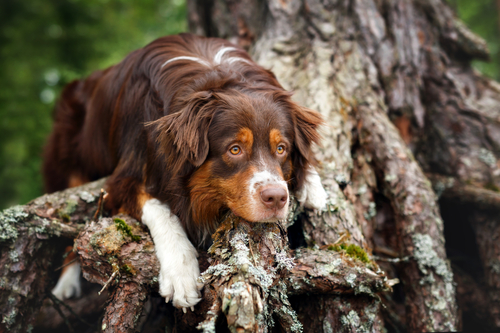Arthritis (inflammation of the joints) is a very common diagnosis for pets and people. It is known to cause pain and stiffness, developing from normal wear and tear or occurring as a result of injury in the past. It is diagnosed by a veterinarian from physical exam findings and radiographic evidence.
Signs Of Arthritis In Dogs
Here are 7 signs that you might not have noticed in your dog that could herald arthritis. It is very important to know that arthritis pain can be managed. Just because it is common, does not mean that is just “normal aging”. If you think that your dog is experiencing one or more of these signs, you should tell your vet. There is help available.

#1 – Difficulty rising
Many owners report that their dogs are slower to get up than when they were when they were young. It can be more difficult to rise from a lying or sitting position with painful joints. Difficulty rising can also be a muscular problem, so ask your vet to help you tell the difference.
#2 – Hesitant to climb steps
Climbing steps is specifically harder for sore dogs because it requires more weight to be applied to fewer legs as they climb, so a limb that usually bears only ¼ of the weight will be required to carry more as the steps are navigated. This difference in weight distribution can highlight lameness and make your dog cautious about changes in floor elevation, like stairs.

#3 – Limping
Some dogs will obviously limp on one leg or another. Many times arthritis sufferers will seem to “warm out” of the lameness as they get moving. This could be because the movement gradually increases circulation and helps get rid of the painful chemicals built up in the inflamed joints. Lameness, even if the dog warms out of it, should be mentioned to a vet since there are many other causes for limping in dogs.
#4 – Falling
Because affected pets may be more tentative in their movements to try to avoid pain, they can easily become off balance and fall more frequently. Stumbling and falling can also be signs of neurologic disorders and even infectious diseases though, so include your veterinary team in getting to the bottom of the falls.
#5 – Slipping on slick surfaces
Older arthritic dogs have a more difficult time navigating slick and hard floors, especially around their favorite places, like the food and water dishes. You can make this easier by placing the dishes on a yoga mat to provide traction and prevent slipping.

#6 – Lying around a lot
Pain can change a dog’s disposition. Owners think that their dogs are “just slowing down”, but if you notice that your pet is not enjoying the things he used to or not wanting to go outside, please seek help. You will be surprised by the improvement most dogs have when their arthritis is managed. There are so many options and your vet is your partner in diagnosing and treating disease.
#7 – Fleas and skin lesions
What? Skin lesions and fleas? Yes, if you notice skin lesions, like calluses or ulcers, your dog might have pressure sores from not feeling like getting up. He may be immobile enough that fleas have noticed him as an easy target. His joints could be discolored from licking because he does not know what to do about the pain.
It would be a shame to miss something as manageable as arthritis because you did not know it could manifest itself in these ways. If your dog is an adult or older or has suffered from orthopedic (bone related) injury in the past, it is worth a veterinary exam. You might bring back the puppy inside once you diagnose and treat what is going on.
Advanced 8-in-1 Hip & Joint Chews for dogs provide natural relief from joint distress for improved flexibility. Every purchase will provide meals for 14 shelter dogs!

 Toledo, United States.
Toledo, United States.